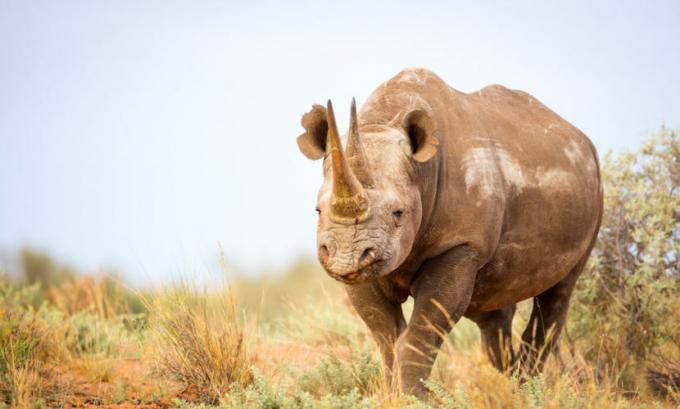rhinos they are mammals of large size that suffered a lot, and still suffer, with illegal hunting, which aims, mainly, to remove the horns of these animals. Unlike what many people think, when we talk about rhinos, we're not just talking about a species. are currently recognized five species of which three are at serious risk of extinction. Rhinoceros are found in Asia and Africa, and Africans are generally more aggressive than Asians.
Taxonomic classification of rhinos
Rhinoceros are mammalian animals that are part of the family rhinoceroteridae. Currently, five species of them are recognized, which are distributed in four genera: white rhinoceros (keratotherium simum), black rhino (Diceros bicorni), Indian rhino (Rhinoceros unicornis), Sumatran rhino (Dicerorhinus sumatrensis) and java rhinoceros (Rhinoceros sonoicus).
Read too: Giraffes - they live in Africa and, due to the increasing reduction of their population, they are vulnerable
General characteristics of rhinos
Rhinoceroses are large animals that have a body.
broad and short legs. In your head, there may bea The twohorns, depending on the species, which are very targeted by hunters. Rhinoceros have small eyes and short ears. Another striking point is the presence of thick skin and sparse hair. In some species, the skin gives a armor appearance.rhinos are herbivorous animals, feeding mainly on grasses or branches. They may have different food preferences, depending on the species studied. They are more active animals at night and in the early morning.

Rhino species are usually lonely, being observed the approach of other individuals during the mating period. Female rhinos give birth to a single offspring every two years. Gestation takes between 420-570 days. The puppy follows the mother until the birth of the next child. Sexual maturity is reached between seven and 10 years for males and between four and six years for females. Rhinoceros usually have a longevity of about 50 years.
The rhino species are territorial. To mark their territory, they use urine and feces. The feces are placed in piles, which can reach up to one meter in height.
Read too: Differences between horns and horns
The five species of rhinoceros
Let's get to know a little more about the five species of living rhinoceros below:
White rhino - keratotherium simum
It is a species classified as "almost threatened" by the IUCN, and the current population trend is declining. Also according to the IUCN, as of December 2017, there were around 18,064 white rhinos in the wild, the majority being distributed in South Africa, Namibia, Kenya, Botswana and Zimbabwe. They are found in savannah, dense forests and woodland regions, usually living near sources of Water. They weigh between 1000 kg and 3600 kg as adults, and have two different sized horns. They have light gray skin.
Black rhinoceros - Diceros bicorni

The species is classified as "critically endangered" by the IUCN, and the current population trend is one of growth. Also according to the IUCN, the species was the most numerous of the world's rhino species during most of the 20th century. The black rhinoceros is found in several habituntil, living in both desert regions of Namibia and rainforest regions. They generally weigh between 800 kg and 1400 kg and have two horns. These animals are not black as the name indicates, and their color is usually gray, but can vary from yellowish brown to dark brown.
Indian Rhinoceros - Rhinoceros unicornis

The species is classified as “vulnerable” by the IUCN, and the current trend of the population is of growth, mainly due to its protection and the management of its habitat in India and Nepal. Also according to the IUCN, in August 2018, it was estimated that the total population consisted of 3588 individuals, distributed in India and Nepal, with the largest number observed in India. They are found living in floodplains. They have only one horn, hence the reference to the term unicorn in their scientific name. They have skin with many folds, which give them the appearance of armor. They can weigh from 1500 kg to 2000 kg.
Sumatran rhinoceros - Dicerorhinus sumatrensis

The species is classified as "critically endangered" by the IUCN, and the current population trend is declining. It is currently estimated, according to the IUCN, that there are less than 80 individuals, occurring only in Indonesia. This species is found in different habitats such as dense forests, moss forests and mountainous areas. It is the smallest of the living rhino species and has two horns, the frontal being more visible. The body color is usually dark gray or brown. It can weigh from 800 kg to 2000 kg.
Rhino of Java - Rhinoceros sonoicus

The species is classified as "critically endangered" by the IUCN, and the current population trend is stable. The Javan rhinoceros is found in Indonesia, living in tropical forest areas, especially near water. It stands out for being the rhinoceros with the smallest horn when we look at all living species. They can weigh between 1500 kg and 2000 kg.
Read too: What are wild animals?
Threats to rhinos
One of the main threats to rhinos is the black market in horns, which is responsible for the death of several individuals every year. In many places, these horns are used in traditional medicine, in addition to being considered status symbols, being used to carve items of high commercial value. Another threat faced by these species are the climate changes, which cause, for example, prolonged droughts, the introduction of invasive species and the destruction of their habitat.



